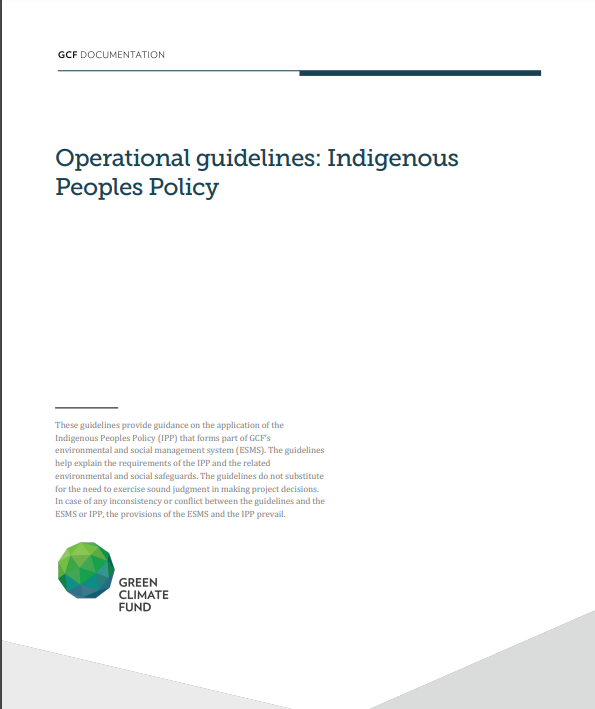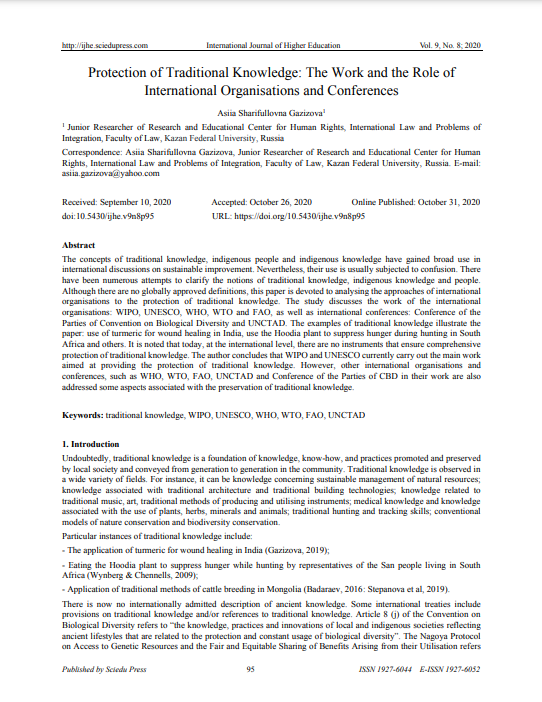Knowledge Hub

Operational guidelines: Indigenous Peoples Policy
2019
Publisher/Organisation: Green Climate Fund
The Policy and these guidelines form a part of the GCF ESMS. The ESMS enables GCF to identify, analyse, avoid, minimize and mitigate any potential adverse environmental and social impacts of its activities, to maximize environmental and social benefits, and to improve the environmental and social performance of GCF and its activities consistently over time.
Implementing Indigenous Self - determination through Legislation in Canada
2017
Publisher/Organisation: John Borrows
Canada and Indigenous peoples should work together to produce legislation which recognizes and affirms Indigenous self-determination. While far from perfect, Indigenous peoples in the United States have created receptive policy frameworks with Congressional allies which builds law on principles of self-determination.

COVID-19 and The World of Work: A Focus on Indigenous and Tribal Peoples
2020
Publisher/Organisation: International Labour Organization
Drawing on new ILO data, this brief analyses the vulnerabilities of indigenous and tribal peoples in the COVID-19 context and identifies urgent and continuing actions to ensure their access to decent work and social protection, as part of the unfolding COVID-19 response and recovery. Highlighting relevant international labour standards and the importance of social dialogue for advancing solutions, the brief also underlines that state institutions for indigenous and tribal peoples’ participation and consultation are essential for building pathways to resilience and sustainable development that leave no one behind.

Protection of Traditional Knowledge: The Work and the Role of International Organisations and Conferences
2020
Author(s): Gazizova AS
It is noted that today, at the international level, there are no instruments that ensure comprehensive protection of traditional knowledge. The author concludes that WIPO and UNESCO currently carry out the main work aimed at providing the protection of traditional knowledge. However, other international organizations and conferences, such as WHO, WTO, FAO, UNCTAD and Conference of the Parties of CBD in their work are also addressed some aspects associated with the preservation of traditional knowledge.

Traditional Knowledge and Intellectual Property Rights: An Indian Perspective
2011
Author(s): Bala A
Biopirates use Intellectual Property Rights (IPR) as tool to steal traditional knowledge and exploit biological resources and this happens because of some limitations in IPR system. Therefore it is required to introduce some sui-generis elements in the existing IPR system.

Strategies to Incorporate and Support Indigenous Knowledge (IK) in Teacher Training Education: Lessons and Insights for Higher Education Institutions in Namibia.
2023
Author(s): Amuthenu SH
The study aims to explore on how indigenous knowledge can be incorporated effectively in the training of teachers in Namibia.

The White/Wiphala Paper on Indigenous Peoples’ food systems
2021
Author(s): Food and Agriculture Organization
This paper highlights the risks of not taking on board the time-tested contributions that Indigenous Peoples have and continue to make for sustainability and territorial management, amongst other dimensions. It also addresses the ongoing policy contradictions and limitations in meeting the Sustainable Development Goals (SDGs), UN Climate Change Conference of Parties’ (COP) debates and international agreements about sustainability.
Indigenous Peoples in Domestic Work – Facing Multiple Discrimination and Disadvantage
2015
Author(s): Oelz M, Dhir RK
This study focuses on Indigenous women facing multiple forms of disadvantage and discrimination because of gender and identity, from both within and outside communities.
Guidelines for Combating Child Labour Among Indigenous and Tribal Peoples (ITPs)
2011
Author(s): International Labour Office
This guide provides practical guidance on how to address the specific needs and rights of indigenous peoples, and thus combat child labour among indigenous children.
Indigenous Peoples and the United Nations Human Rights System
2013
Author(s): United Nations Human Rights
This Fact Sheet provides an overview of the United Nations human rights system and the rights of indigenous peoples.



